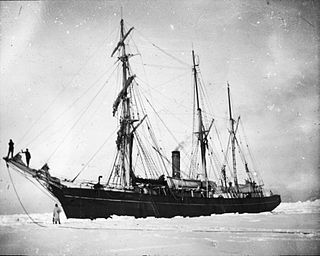
Nimrod was a wooden-hulled, three-masted sailing ship with auxiliary steam engine that was built in Scotland in 1867 as a whaler. She was the ship with which Ernest Shackleton made his Nimrod Expedition to Antarctica in 1908–09. After the expedition she returned to commercial service, and in 1919 she was wrecked in the North Sea with the loss of ten members of her crew.

Jun'yō Maru (順陽丸) was a cargo steamship that was built in Scotland in 1913, served a succession of British owners until 1927, and was then in Japanese ownership until a Royal Navy submarine sank her in 1944.

SS Southern Cross was a steam-powered sealing vessel that operated primarily in Norway and Newfoundland.
SS Chenab was a steamship that was built in England in 1911 and scrapped in Scotland in 1953. For nearly two decades she was part of Nourse Line, which carried Girmityas from India to colonies in the Caribbean and the Pacific. In 1914 she was requisitioned for service in the First World War.
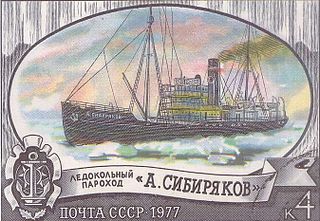
Alexander Sibiryakov was a steamship that was built in Scotland in 1909 as Bellaventure, and was originally a seal hunting ship in Newfoundland. In 1917 the Russian government bought her to be an icebreaker. She served the RSFSR and Soviet Union until 1942, when she was sunk by enemy action. The ship gave notable service in the Russian Arctic during the 1930s.
SS Montrose was a British merchant steamship that was built in 1897 and wrecked in 1914. She was built as a cargo liner for Elder, Dempster & Company. In 1903 the Canadian Pacific Railway bought her and had her converted into a passenger liner.

SS Statendam was a transatlantic ocean liner that was launched in Ireland in 1898 for Holland America Line. She was the first of several ships in the company's history to be called Statendam. She was NASM's first ship of more than 10,000 GRT, and she was the largest ship in the company's fleet until Potsdam was completed in 1900.

USS Charlton Hall (ID-1359) was a cargo steamship that was built in Scotland in 1907 and served in the merchant fleets of the United Kingdom, United States and Greece. She served in the United States Navy in 1918. She was renamed Atlantis and then Anastasis in 1930. She was scrapped in China in 1934.
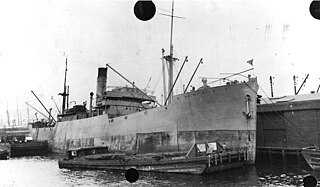
USS Craster Hall (ID-1486) was a cargo steamship that was built in Scotland in 1909 and served in the merchant fleets of first the United Kingdom and then the United States. From 1918 to 1919, she served in the United States Navy. In 1927, she was damaged in a collision off the coast of Peru, was beached to prevent her sinking, but was wrecked.

SS Polar Chief was a merchant steamship that was built in England in 1897 and scrapped in Scotland in 1952. In her 55-year career she had previously been called Montcalm, RFA Crenella, Crenella, Rey Alfonso, Anglo-Norse and Empire Chief. Early in the First World War she spent eight months pretending to be the battleship HMS Audacious.

HMAS Grantala was a passenger steamship that was built in England in 1903 as a coastal interstate liner for the Adelaide Steamship Company. In 1914 the Commonwealth government requisitioned her as a Royal Australian Navy hospital ship.

SS Themistocles was a UK steam ocean liner and refrigerated cargo ship. She was launched in 1910 in Ireland and scrapped in 1947 in Scotland. She was built for Aberdeen Line, White Star Line managed her for a few years, and she spent the latter part of her career with Shaw, Savill & Albion Line.
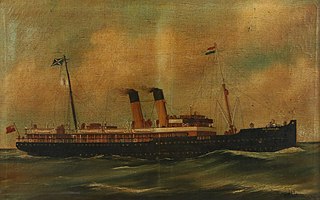
SS St Petersburg was a North Sea passenger ferry that was built in Scotland in 1908 for the Great Eastern Railway (GER). In the 1923 railway grouping she passed to the new London and North Eastern Railway (LNER). She was sunk by enemy action in 1941.
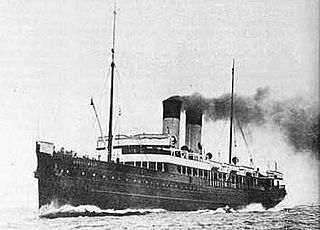
SS Copenhagen was a North Sea passenger ferry that was built in Scotland in 1907. She was the Great Eastern Railway (GER)'s first turbine steamship. In 1916 she was requisitioned as an ambulance ship. A U-boat sank her in 1917 with the loss of six lives.

SS Munich was a North Sea passenger ferry that was built in Scotland in 1908 for the Great Eastern Railway (GER). In the 1923 railway grouping she passed to the new London and North Eastern Railway (LNER). She was scrapped in England in 1950.

SS Grampian was a transatlantic ocean liner that was built in Scotland in 1907 and scrapped in the Netherlands in 1925. She was operated originally by Allan Line, and later by Canadian Pacific Steamships. In the First World War she remained in commercial service but carried Canadian troops. In 1919 she survived a collision with an iceberg. In 1921 she was gutted by fire while being refitted. The refit was abandoned, and in 1925–26 she was scrapped.

SS Stephano was a passenger liner and sealing ship, owned by Bowring Brothers and operated in their Red Cross Line of Arctic steamships. Stephano is most notable for her role in the 1914 Newfoundland Sealing Disaster, under the command of Captain Abram Kean. Stephano was the sister ship to the SS Florizel.

SS Franz Fischer was an iron-hulled collier that was built in England as Rocklands in 1881, renamed Franz Fischer in 1913, and sunk by enemy action in 1916. She was owned and registered in Britain until 1896, when she passed to German owners. In August 1914 the UK Admiralty seized her and placed her under British civilian management.
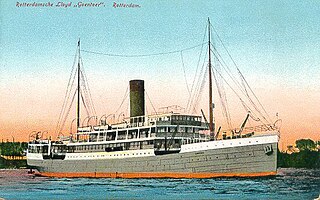
SS Goentoer was a Dutch passenger and mail ship that was built for Rotterdamsche Lloyd in 1902 and scrapped in 1925. Her regular route was between Rotterdam and the Dutch East Indies. She was a UK troop ship from 1918 to 1919, after being seized under angary in Singapore.
SS Aguila was a British merchant steamship that was built in Scotland in 1909. She was one of a small fleet of ships that Yeoward Brothers ran between Liverpool and the Canary Islands, importing fruit to Britain, and carrying passengers in both directions. A U-boat sank her in 1915.




















